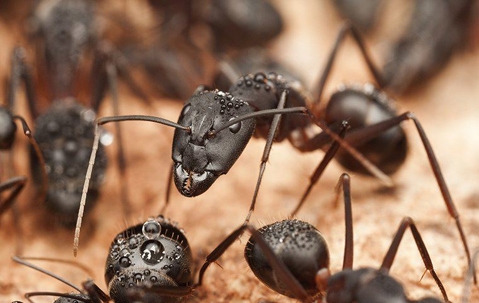Southern California is full of attractants, not just for humans, but for ants as well. Ants are one of the most common household pests found in Southern California. They’re tiny, they live together in massive colonies, and once they infest, they are not easy to eliminate.
Some of the most common Southern California ants are:
- Argentine ants
- Carpenter ants
- Fire ants
- Harvester ants
- Little black ants
- Odorous house ants
- Pavement ants
- Pharaoh ants
- Thief ants
- Velvety tree ants
Depending on the species, ants can pose a number of problems. Carpenter ants, for example, can cause large-scale property damage by excavating through wood. They’re the ant species that poses the biggest threat to the structure of your Southern California property.
Pavement ants can travel through the plumbing and electrical systems, threatening the function and safety of the building. Argentine ants are threatening to yards and lawns, and thief ants pose a threat in the kitchen as they tend to get into packaged foods. (They love sweets and grease and can infest your cupboard in large numbers.)
One thing all ant species have in common is the fact that they can contaminate food sources. Ants hang out around decaying matter, possibly picking up all kinds of bacteria and pathogens, that they then can transfer to foods and vulnerable surfaces. This contamination can lead to a long list of health conditions and bacterial infections, such as:
- E.coli
- Streptococcus
- Salmonella
- Staphylococcus
- Shigella
When it comes to ant prevention, the best place to start is eliminating ant attractants. Reducing sources of food, water, and shelter is key to keeping ants out. Here are some precautionary steps you can take to lower your chances of having an ant infestation:
- Avoid leaving pet food out overnight, and store it in sealed plastic containers.
- Clean off counters, sticky jars, or any residue that could attract ants.
- Eliminate points of entry; seal all cracks and crevices around the outside of the home.
- Fix leaky pipes, faulty facets, and dysfunctional drains.
- Get rid of any sources of standing water and excess moisture.
- Keep branches, trees, and bushes well-trimmed; direct them away from the house.
- Keep functional downspouts and gutters so water is directed away from the foundation.
- Maintain proper cleanliness and practice a high level of sanitation.
- Promptly wipe up spills and crumbs; keep food in tightly sealed containers.
- Put dehumidifiers in damper areas of the house like basements, crawl spaces, and attics.
- Take the trash out frequently; keep it in a lidded garbage can outside.
If you suspect ant activity, but you’re not quite sure, you can look for certain entry points where ants may potentially be gaining access to your property. They’re usually in moist areas, like the kitchen, bathroom, and laundry room; be sure to check the floor drains and utility areas. Ants also tend to congregate under household appliances, cable wires, water lines, and gas lines.
Be on the lookout for any cracks and crevices around walls and cabinets. It’s crucial to seal these areas with caulk to prevent future access. Of course, it can be difficult to block off all points of entry since ants are extremely tiny; they can fit into the smallest cracks and crevices in the most inaccessible places.
There are baits, traps, and gels, and other take-home DIY methods that promise lasting ant-control results, but ants can infest in such large numbers that you can never quite cover all of them with these methods. That’s why you need assistance from the pest control professionals.
For the best, most reliable form of ant control in the area, contact the professionals at Excel Pest Management. We’re ready to identify the problem and come up with the perfect solution. Our goal is to keep your property pest-free all year long, so give us a call today to get started with effective ant control services.

